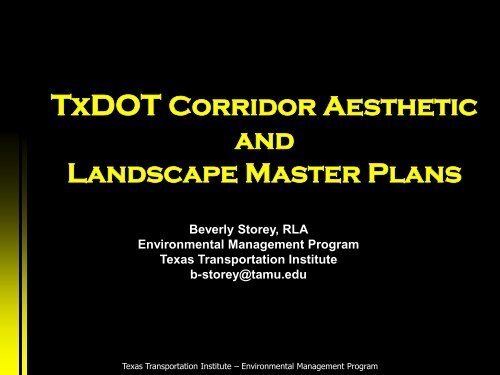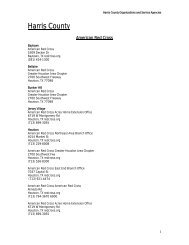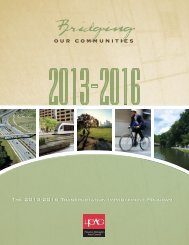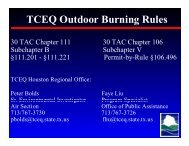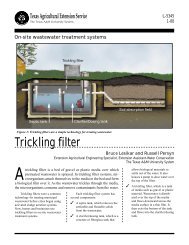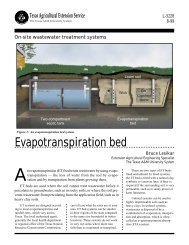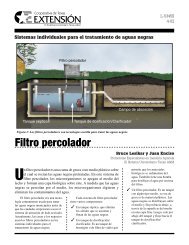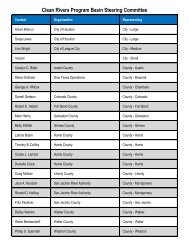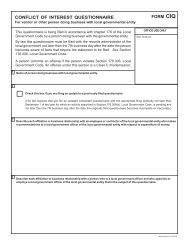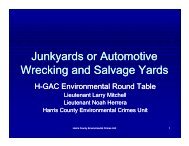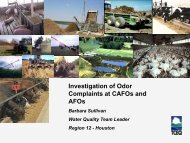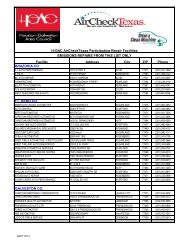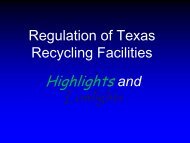TxDOT Corridor - Aesthetic and Landscape Master Plan - Houston ...
TxDOT Corridor - Aesthetic and Landscape Master Plan - Houston ...
TxDOT Corridor - Aesthetic and Landscape Master Plan - Houston ...
You also want an ePaper? Increase the reach of your titles
YUMPU automatically turns print PDFs into web optimized ePapers that Google loves.
<strong>TxDOT</strong> <strong>Corridor</strong> <strong>Aesthetic</strong><br />
<strong>and</strong><br />
L<strong>and</strong>scape <strong>Master</strong> <strong>Plan</strong>s<br />
Beverly Storey, RLA<br />
Environmental Management Program<br />
Texas Transportation Institute<br />
b-storey@tamu.edu<br />
Texas Transportation Institute – Environmental Management Program
What is L<strong>and</strong>scape <strong>and</strong> <strong>Aesthetic</strong>s<br />
Design in Transportation?<br />
“With respect to the practice of transportation design, aesthetics<br />
may be defined as dealing with the visual integration of highways<br />
<strong>and</strong> other transportation modes into the fabric of a l<strong>and</strong>scape in a<br />
way that blends with or complements that setting.”<br />
“An aesthetically pleasing highway or other transport mode is<br />
one that provides its users with a clear picture of what is going<br />
on around them <strong>and</strong> what is expected of them.”<br />
“This means that aesthetics planning is a process that occurs<br />
at every stage of design, construction, <strong>and</strong> maintenance.”<br />
- <strong>TxDOT</strong> L<strong>and</strong>scape & <strong>Aesthetic</strong>s Design Manual<br />
Texas Transportation Institute – Environmental Management Program
Structural <strong>Aesthetic</strong>s<br />
<strong>Plan</strong>ting Design<br />
Public Art<br />
Site Fixtures<br />
Maintenance<br />
Texas Transportation Institute – Environmental Management Program
The <strong>TxDOT</strong> Design Manual<br />
<br />
Introduces l<strong>and</strong>scape <strong>and</strong><br />
aesthetic design concepts<br />
<br />
Highlights issues designers<br />
should consider<br />
Texas Transportation Institute – Environmental Management Program
“… context sensitive design<br />
seeks to avoid … conflicts<br />
<strong>and</strong> form partnerships with<br />
the communities to meet<br />
transportation needs <strong>and</strong><br />
user expectations.”<br />
Texas Transportation Institute – Environmental Management Program
Conduct Early Coordination<br />
with Stakeholders<br />
Texas Transportation Institute – Environmental Management Program
What is a <strong>Corridor</strong> <strong>Aesthetic</strong><br />
<strong>and</strong><br />
L<strong>and</strong>scape <strong>Master</strong> <strong>Plan</strong>?<br />
Texas Transportation Institute – Environmental Management Program
What do the <strong>Master</strong> <strong>Plan</strong>s do for each District?<br />
Provide the Why, What, Where, When & How<br />
The <strong>Master</strong> plan will be in the form of written guidelines which<br />
may contain plan sheets <strong>and</strong> details as appropriate.<br />
<br />
<br />
<br />
<br />
<br />
<br />
<br />
<br />
<br />
Define the playing field <strong>and</strong> establish the rules for each District<br />
Offer guidance <strong>and</strong> direction for all levels of the District staff<br />
State the District’s goal regarding l<strong>and</strong>scape <strong>and</strong> aesthetic design<br />
Set objectives the District will work toward<br />
Establish design st<strong>and</strong>ards<br />
Be a sales tool for <strong>TxDOT</strong>’s mission<br />
Educate the community<br />
Provide opportunity for community participation<br />
Define the roles <strong>and</strong> responsibilities of District <strong>and</strong> the community<br />
The <strong>Master</strong> <strong>Plan</strong> is not a project design plan<br />
Texas Transportation Institute – Environmental Management Program
Public Meetings<br />
Gets stakeholders involved<br />
Gathers feedback<br />
Conveys complex concepts<br />
Texas Transportation Institute – Environmental Management Program
Texas Transportation Institute – Environmental Management Program
Texas Transportation Institute – Environmental Management Program
Different <strong>TxDOT</strong> District Approaches<br />
Texas Transportation Institute – Environmental Management Program
El Paso District<br />
TEXAS DEPARTMENT OF TRANSPORTATION<br />
EL PASO DISTRICT<br />
LANDSCAPE AND AESTHETICS DESIGN<br />
POLICY MANUAL<br />
<br />
Set where <strong>and</strong> when certain types of<br />
l<strong>and</strong>scape development would take<br />
place based on level of development<br />
adjacent to the roadway<br />
<br />
Provided st<strong>and</strong>ards for design <strong>and</strong><br />
distance requirements for installation<br />
Prepared by<br />
The Texas Transportation Institute<br />
Texas A&M University<br />
Under the Direction of<br />
Maribel P. Chávez, P.E.<br />
District Engineer, El Paso District<br />
<br />
<br />
Included an assessment of current<br />
roadways <strong>and</strong> a prioritization of<br />
retrofit projects<br />
Procedure for estimating l<strong>and</strong>scape<br />
installation <strong>and</strong> maintenance costs<br />
July, 2000<br />
Texas Transportation Institute – Environmental Management Program
El Paso District<br />
IMPORTANT FINDINGS OF THE STUDY<br />
<br />
Importance of views; particularly of the Franklin Mountains<br />
<strong>and</strong> the vista towards Juarez<br />
<br />
Inability of respondents to identify specific attractive<br />
or unattractive roadway sections<br />
<br />
Overall impression of IH10 was “dirtiness, hot, dry,<br />
weedy, harsh concrete”<br />
Texas Transportation Institute – Environmental Management Program
Laredo District<br />
AESTHETIC DESIGN POLICY GUIDE<br />
<br />
<br />
<br />
<br />
<br />
District <strong>and</strong> community interviews identified roadside<br />
vegetation as the preferred l<strong>and</strong>scape aesthetic<br />
Set new st<strong>and</strong>ards for vegetation establishment <strong>and</strong><br />
maintenance<br />
Developed st<strong>and</strong>ard slope treatments<br />
Developed a plant pallet, irrigation st<strong>and</strong>ards,<br />
<strong>and</strong> planting guidelines<br />
Emphasized community participation for<br />
high-maintenance projects<br />
Texas Transportation Institute – Environmental Management Program
Green Ribbon<br />
Program<br />
From <strong>Plan</strong> To Project<br />
The GRP is the <strong>Houston</strong> District’s response to the<br />
local legislative <strong>and</strong> public dem<strong>and</strong> to incorporate a<br />
higher level of aesthetics <strong>and</strong> l<strong>and</strong>scape development<br />
into the state’s roadway facilities.<br />
Texas Transportation Institute – Environmental Management Program
PARTICIPANTS<br />
<br />
<br />
<br />
<br />
<br />
Texas Department of Transportation (<strong>TxDOT</strong>)<br />
<strong>Houston</strong> District<br />
Texas Transportation Institute (TTI)<br />
Environmental Management Program<br />
Consultant Project Design Team<br />
Engineers, Architects, L<strong>and</strong>scape Architects, Urban Designers, <strong>and</strong> Cultural<br />
Arts Council of <strong>Houston</strong> <strong>and</strong> Harris County.<br />
Green Ribbon Committee<br />
Representatives from various arts, cultural, civic, business, environmental<br />
groups <strong>and</strong> local government officials, to assist <strong>TxDOT</strong> in obtaining feedback.<br />
Through their time <strong>and</strong> effort developed consensus-based design<br />
criteria that will long serve the <strong>Houston</strong> District.<br />
Implementation Team<br />
Consultant design team <strong>and</strong> appointed members by the<br />
District Engineer.<br />
Texas Transportation Institute – Environmental Management Program
MISSION STATEMENT<br />
Develop a plan that provides a ―road map‖ for<br />
aesthetic quality of roadside development <strong>and</strong><br />
creates an enhanced highway environment<br />
that is recognizable as a system.<br />
Texas Transportation Institute – Environmental Management Program
MASTER PLANNING DEVELOPMENT GUIDELINES<br />
Provided to acquaint the<br />
design professional with<br />
the issues that are to be<br />
considered when<br />
planning or designing<br />
l<strong>and</strong>scape development<br />
<strong>and</strong> aesthetic<br />
improvement projects for<br />
the <strong>Houston</strong> District<br />
urban highway system.<br />
Texas Transportation Institute – Environmental Management Program
DELIVERABLES (PHASE I)<br />
Established Goals <strong>and</strong><br />
Design Principles for:<br />
Architecture<br />
L<strong>and</strong>scape Architecture<br />
Public Art<br />
Established Guidelines for:<br />
L<strong>and</strong>scape Architecture<br />
Public Art<br />
Texas Transportation Institute – Environmental Management Program
DISCLAIMER (PHASE I)<br />
<strong>TxDOT</strong> does not have the financial<br />
resources to implement all of the<br />
proposed design concepts.<br />
Successful public/private<br />
partnerships with the community can<br />
broaden the impact of available<br />
<strong>TxDOT</strong> funding.<br />
Texas Transportation Institute – Environmental Management Program
DELIVERABLES (PHASE II)<br />
The design criteria provided acts as the overall guideline<br />
necessary to produce the preferred aesthetic form, function<br />
<strong>and</strong> appearance of each new BASELINE highway element.<br />
Texas Transportation Institute – Environmental Management Program
STANDARDS<br />
Texas Transportation Institute – Environmental Management Program
IMPLEMENTATION<br />
ARCHITECTURE<br />
Retaining Walls<br />
Texas Transportation Institute – Environmental Management Program
Columns<br />
Texas Transportation Institute – Environmental Management Program
Sound Walls<br />
Texas Transportation Institute – Environmental Management Program
L<strong>and</strong>scape Pavers<br />
Texas Transportation Institute – Environmental Management Program
LANDSCAPE ARCHITECTURE<br />
Native Naturalized “Reforestation”<br />
Texas Transportation Institute – Environmental Management Program
Texas Transportation Institute – Environmental Management Program
Texas Transportation Institute – Environmental Management Program
PARTNERSHIPS<br />
Texas Transportation Institute – Environmental Management Program
Public Art<br />
Texas Transportation Institute – Environmental Management Program
Before<br />
After<br />
Texas Transportation Institute – Environmental Management Program
ACCOMPLISHMENTS<br />
<br />
<br />
PUBLIC RELATIONS TOOL<br />
An education process<br />
Commitment by <strong>TxDOT</strong><br />
Consensus based design<br />
LEGISLATIVE ACTION - Commitment by the public<br />
2002-2003 77 th Regular Session – Rider 57 to the<br />
general appropriations bill for <strong>TxDOT</strong> – Minimum ½%<br />
of total letting $’s for l<strong>and</strong>scape development<br />
associated with plant materials in non-attainment <strong>and</strong><br />
near non-attainment counties, <strong>and</strong> aesthetic master<br />
plans for cities in excess of 100,000 population.<br />
Texas Transportation Institute – Environmental Management Program
ACCOMPLISHMENTS<br />
2004-2005<br />
78th Regular Session – Rider 49 to the general appropriations bill for<br />
<strong>TxDOT</strong> – Minimum ½% of total letting $’s for l<strong>and</strong>scape development<br />
associated with plant materials in non-attainment <strong>and</strong> near<br />
non-attainment counties.<br />
2006-2007<br />
79th Regular Session – Rider 23 to the general appropriations bill for<br />
<strong>TxDOT</strong> – Minimum ½% of total letting $’s for l<strong>and</strong>scape development<br />
associated with plant materials in non-attainment <strong>and</strong> near<br />
non-attainment counties.<br />
New Federal Transportation Bill<br />
SAFETEA-LU (Safe Accountable Flexible Efficient Transportation<br />
Equity Act: A Legacy for Users) Reference to high priority project<br />
No.825, Implementation <strong>and</strong> quantification of benefits of Large-scale<br />
l<strong>and</strong>scape along freeways <strong>and</strong> interchanges in the <strong>Houston</strong> region.<br />
Texas Transportation Institute – Environmental Management Program
ACCOMPLISHMENTS<br />
PARTNERSHIPS<br />
Mutual underst<strong>and</strong>ing<br />
Opportunities to define identity<br />
Cash <strong>and</strong> In-kind contributions<br />
Long term commitments<br />
DESIGN, CONSTRUCTION & MAINTENANCE<br />
Consistency by guidelines <strong>and</strong> st<strong>and</strong>ards (Design)<br />
Consistency in form <strong>and</strong> materials (Construction)<br />
Consistency in materials <strong>and</strong> methods (Maintenance)<br />
Texas Transportation Institute – Environmental Management Program
RECOGNITION<br />
AWARDS:<br />
National Arbor Day Award, 2005, Lady Bird Johnson Award, The National Arbor Day Foundation.<br />
Environmental Achievement Award, 2003, Texas Department of Transportation.<br />
National Arbor Day Award, 2003, Lady Bird Johnson Award, The National Arbor Day Foundation.<br />
Certificate of Recognition, 2003, Mayor’s Proud Partners Award, Keep <strong>Houston</strong> Beautiful.<br />
Arboricultural Project Award, 2003, Texas Forest Service <strong>and</strong> Texas Urban Forest Council.<br />
Arbor Day Award, 2003, Trees For <strong>Houston</strong>.<br />
Award of Appreciation for Endeavors Toward Water Conservation <strong>and</strong> Beautification Efforts, 2002, Nelson, Turf<br />
Division.<br />
Best Use of Water Conservancy Products, 2001, Rainbird, Texas/Oklahoma Region.<br />
Award of Excellence, 2001, Texas Community Forestry Award, Government Project, Texas Forest Service <strong>and</strong> Texas<br />
Urban Forest Council.<br />
National Arbor Day Award, 2001, Lady Bird Johnson Award, The National Arbor Day Foundation.<br />
Arbor Day Award, 2000, Trees For <strong>Houston</strong>.<br />
Visionary Award, 2000, The Park People, Inc., <strong>Houston</strong>.<br />
Merit Award, 2000, <strong>Plan</strong>ning <strong>and</strong> Analysis, American Society of L<strong>and</strong>scape Architects, Texas.<br />
Highest Honor, 1999, Strategic <strong>Plan</strong>ning Effort, The American <strong>Plan</strong>ning Association, <strong>Houston</strong>.<br />
Award of Merit, 1999, Texas Community Forestry Award, Local Government, Texas Forest Service <strong>and</strong> Texas Urban<br />
Forest Council.<br />
OTHER:<br />
Published as case study for, Transportation Public/Private Partnership Guide Book, Somerset County <strong>Plan</strong>ning Board,<br />
New Jersey.<br />
NOMINATED:<br />
AASHTO President’s Transportation Award, Environment Category, 2003, 2004.<br />
Star Award, 2002, <strong>Houston</strong> West Chamber of Commerce, Westchase District.<br />
President’s Award, Best Public Improvement Project, 2002, Texas Downtown Association.<br />
AASHTO National Environmental Stewardship Competition, 2002, Program Catagory<br />
<strong>TxDOT</strong> Environmental Award, 2001<br />
Texas Transportation Institute – Environmental Management Program
<strong>Master</strong> <strong>Plan</strong>s/<strong>Corridor</strong> <strong>Plan</strong>s<br />
large or small …the process is the same<br />
<br />
<br />
<br />
<br />
<br />
<br />
Determine the direction <strong>and</strong> the goals the District wants<br />
to pursue<br />
Meet with individuals/sections/areas to discuss issues<br />
Develop a preliminary outline based on input from<br />
district personnel<br />
<strong>Plan</strong> your public participation activities<br />
Develop the manual<br />
Prepare an implementation procedure<br />
Texas Transportation Institute – Environmental Management Program
―Transit agencies typically keep the public at bay<br />
by having only two phases for their projects:<br />
The first phase when it is just too early to give the<br />
public all the facts, <strong>and</strong> the second phase when it<br />
is too late to stop the project.‖<br />
— Earnest Fitzgerald<br />
December 17, 2005 Today's quote:<br />
http://www.honolulutraffic.com/Dec05_JanFeb06.htm<br />
Texas Transportation Institute – Environmental Management Program
THANKS, Y’ALL!<br />
QUESTIONS ?<br />
Texas Transportation Institute – Environmental Management Program


